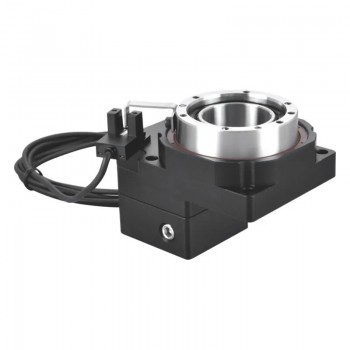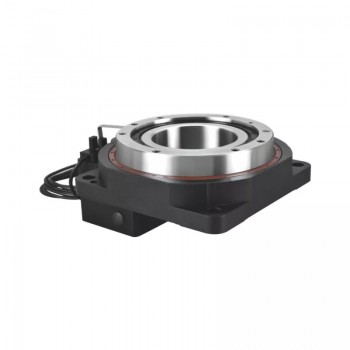1.Main introduction of hollow rotary actuator
A hollow rotary actuator is an electric motor and gearing system with a large, central hole in the output shaft, which is ideal for routing wires and tubes. It simplifies equipment design by allowing users to mount components like tables or arms directly onto the output flange, eliminating the need for belts or pulleys and saving space and cost. This type of actuator uses a combination of a high-rigidity output table with cross-roller bearings and a high-torque stepper or servo motor to achieve accurate, precise, and powerful positioning for applications like robotics and automated manufacturing.

2.Main parts of hollow rotary actuator
1.Integrated Motor: A high-accuracy motor, frequently a closed-loop stepper or servo motor, provides the power for the actuator’s movement.
2.Hollow Output Table: A large, central, hollow section that allows for cables, wiring, or air lines to be passed directly through the actuator’s center, simplifying design and reducing the overall footprint of the equipment.
3.High-Rigidity Bearing: A critical component, often a cross-roller bearing, that is integrated with the hollow table to support the load and ensure high rigidity and accuracy during rotation.
4.Internal Gear Train: A precision-engineered gear train, which can include both input and output gears, that is designed to reduce speed while increasing torque.
5.Housing: A structurally reinforced housing that encloses the internal components and protects them from external contaminants, while also providing mounting points.
3.Key features and benefits of hollow rotary actuator
1.Hollow center: The large, hollow through-hole is the defining feature, allowing for simplified design by routing cables, tubes, and other components through it, which also reduces the overall footprint of the equipment.
2.Direct mounting: A table, arm, or other load can be mounted directly onto the output flange. This eliminates the need for external transmission components like belts, pulleys, and couplings, which can be costly and complex to install and adjust.
3.High precision: Hollow rotary actuators are designed for highly accurate and repeatable positioning, often with minimal backlash. This is achieved through the integrated gear reduction and high-resolution stepper or servo motors.
4.High torque and rigidity: The use of cross-roller bearings in the output table provides high permissible load and moment capacity, enabling the actuator to handle large inertia loads and heavy payloads.
5.Ease of use: They integrate a motor, driver, and control system, making them a more complete package than traditional motor-and-belt setups. Many models can be controlled via standard I/O or industrial networks like Modbus.
6.Application examples: They are commonly used in applications such as semiconductor manufacturing equipment, robotic arms, indexing tables, and part mounters where precise and repeatable motion is required.

4.Selection tips of hollow rotary actuator
1.Torque and Load: Calculate the required torque and consider the moment of inertia of the load to ensure the actuator can handle the rotational force and acceleration/deceleration. You should verify the required torque falls within the actuator’s torque-speed characteristics.
2.Speed and Position: Check the required speed and positioning accuracy (e.g., repeatability) for the application to ensure the actuator can meet the desired cycle times.
3.Axial and Moment Loads: Calculate the axial and moment loads and confirm they are within the actuator’s specifications. For example, the moment of inertia of the load should be appropriately sized relative to the actuator’s own inertia—a common guideline is a maximum load-to-actuator inertia ratio of 30:1.
4.Accuracy: Evaluate factors like positioning accuracy, parallelism, and concentricity to ensure the actuator can achieve the required precision.
5.Life and Durability: Consider the required lifespan (in operating hours) and the degree of protection (IP rating) needed for the operating environment.
6.Installation and Integration: Take into account the actuator’s features, such as a hollow flange for direct mounting, which can reduce parts and simplify design and assembly. Also, consider the communication protocols supported if integrating with a factory automation network.
7.Calculation and Verification: Use manufacturer-provided tools and formulas to calculate load, torque, and speed requirements. You can then use the actuator’s performance graphs and specification sheets to confirm your choice is suitable.